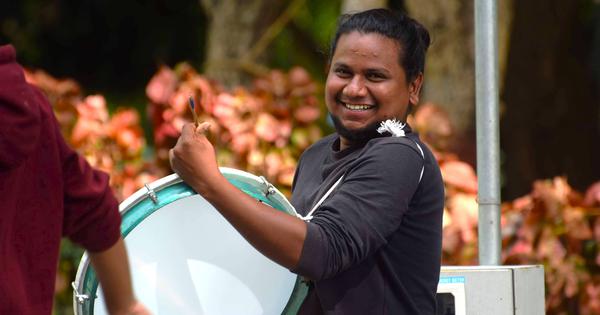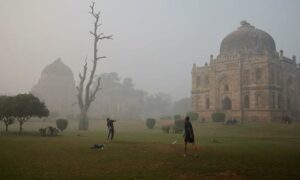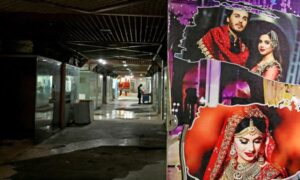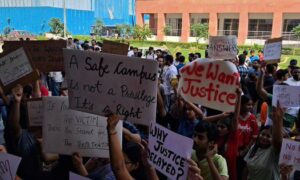
For a long time, the tamate has been considered an “untouchable” instrument in Karnataka and Andhra Pradesh because caste Hindu groups associate it with communities that work with leather and perform funeral rites.
Since the last two years, 26-year old Bharath Dingri has been conducting tamate workshops to recontexualise the beats of the percussion instrument – which is also known as the halgi – as a symbol of the dignity and artistic identity of Dalit communities.
Dingri, the founder of a socio-cultural collective in Bengaluru called Halgi Culture, aims to popularise the rich, sonic histories of Dalit cultures.
Through his workshops, he is building on the altered context for the instrument set out by the Dalita Sangharsha Samiti. The Dalit rights organisation founded in 1975 by significant Kannada literary figures such as B Krishnappa, Siddalingaiah and B Siddaiah turned poetry into songs, accompanied by the beats of the tamate to draw huge crowds for their protests and meetings.
In this lightly edited interview, Dingri speaks about how political consciousness can grow through songs, theatre and poetry. He also discusses his own innovations in teaching the tamate and using the instrument to spread awareness of structural injustice.
What is the tamate?
The tamate is a musical instrument – a drum. When you skin a dead cow and use the intestines to cure, treat and agonise the hide to manifest sound, the tamate is born. It brings life back into dead skin.
Other instruments are also made this way of course: the tabla, the dholak, the djembe. But everyone plays these instruments. The idea that the tamate can only be touched and played by certain communities is astounding.
You know how we feel such a fundamental need to be touched and to touch the skin of another person? The tamate’s skin needs that too.
I have learned this through my own journey with the tamate: it needs to be touched, it needs the warmth of the human body. Its sound is born, grows and changes through the warmth of touch.
How long has the tamate been around?
My father once told me this story: when a cow dies, all the meat is eaten by communities forced to live off discarded food. When the meat is gone, all you’re left with is the hide. But the hide cannot be discarded. That’s not the luxury of people living off discarded food. So they must have thought about what to do with it, and used the most basic tools they had in hand to create this instrument.
I have heard that they even used the organ meat to form a string instrument. The tamate must also have been made the same way, by creating knowledge through their labour.
There is a strong relationship between the food people eat and the labour they do. I think it is also important to remember that it comes from the idea of not wasting the little resources you have.
Why is the tamate considered an “untouchable” instrument?
All [Indian percussion] instruments are really made by Dalits, if you think about it. How is it easy to wear leather slippers made by Dalits, play musical instruments made by Dalits and then say some instruments cannot be touched?
The difference with the tamate is what it is used for too. It is used to perform “chaakri kelasa” [slave labour] for the oppressor castes. That we have to play the tamate only for the oppressor caste’s funeral rites is slave labour.
Why do you think equality is so deeply entrenched in Dalit communities? And what is the history of resistance against “slave labour”?
Look at the celebrations and rituals in Dalit communities. It is so different from that of the Brahmins. Even in their prayer rituals, you’ll see how people keep their distance from each other. You can’t enter the temple, you can’t enter the inner sanctuary, you can’t touch the priest.
With Dalit communities, the celebrations and ceremonies don’t happen in exclusive circles like this. Equality here is a philosophy and a pragmatic solution to external inequalities. The potential for resistance, for my own resistance, comes from here.
Why there hasn’t been a greater resistance movement before this moment should tell us something about how fear, real fear, of being stripped of your dignity, your livelihood and your life turned people into slaves. There was never the opportunity or goal of freedom, there was only death.
What do you think the transformation has been from the way your ancestors played the tamate and the way you do now?
I can play the tamate because that’s not the only thing I do. When I was told I couldn’t get onto the metro train if I carried the tamate with me, I resisted. I fought back. But that courage comes with knowing that playing the tamate is not my livelihood. Unlike my ancestors who had no choice but to play it so they could feed themselves, I know I will and can pick up any other work to sustain myself.
That said, I also refuse to play the tamate without sounding out this pain of a long burdened history. Every time I play the tamate, I am aware that the instrument is delicate, fragile, tender still with these histories of pain. The learning that comes from creating sound out of dead skin is powerful.
How long have you been playing the tamate? Tell us more about that journey.
This has been a long journey. I must have been 10-12 years old when I started playing the tamate. My father used to play the tamate, so I played it too. It never occurred to me that this is an untouchable instrument or that I shouldn’t play it. I played it in public once at a talent show and everyone appreciated my performance.
Later, I would go with my father from village to village, playing the tamate for his street plays. But he never told me about the history of the tamate, even the idea that it is only us, the Madigas who play the tamate. I liked the instrument, so I played it.
Once, a landlord in the village asked me to teach his son how to play the tamate. So I went to their house to teach him. The first two days went okay. On the third day, a cousin of this student pushed me out of the house, outraged that I had dared to step into their house. I went back home and wept. The humiliation was too great. I decided I was going to give up playing the tamate.
It came to me all at once that playing the tamate was shameful, not artistic, not for personal enjoyment or public entertainment but shameful. I didn’t want to play it anymore. My father didn’t try arguing against it. He agreed that if it brought me pain I shouldn’t play it.
I began playing other instruments. I learnt to play so many other instruments. I liked it; I realised that there was no shame attached to any other instrument and I could play it freely. It would take me more time to realise that the tamate is also the identity of my community; that for decades it has been played as a political gesture; a gesture of resistance. It would take me more time to pick up the tamate again.
Can you tell us more about how you learnt about the politics of the tamate?
I learnt about BR Ambedkar from my father, not books. “I will burn the Constitution myself, if Dalits are not ensured equality.” I learnt these songs from my father. I realised that Ambedkar was someone who worked to ensure the dignity of people like me.
Then, there was Samvada Baduku [a community college run by Samvada, a nonprofit]. When I did my journalism course there, I started understanding things about who I am, what I should do. Am I a percussionist? Is that all?
We had to do a media internship for seven months, which I greatly enjoyed because I could build a foundation for work. I learnt what it meant to begin an inquiry.
Then, there was the play, Daklakatha Devikavya [by the Jangama Collective, 2022]. In my previous theatre experience I didn’t have the right to play the tamate. No, I don’t mean opportunity. There wasn’t an environment there that would allow for an instrument like the tamate to be played. They had their own ways of doing things, their own circle of trusted people, their own idea of art, their own idea of work. I also think caste discrimination is insidious and rampant in theatre spaces.
What happened during the process of making Daklakatha that changed the way you thought about the tamate?
If understanding caste politics and aesthetics was an outward journey, Daklakatha was the point at which I began an internal journey of discovering what the tamate is, what my connection is with the tamate and that I have a greater purpose with this instrument.
After I play the tamate, I feel like I have said my piece now, and you have heard it. In that anger and anguish, I am now realising that it is not just mine but the pain of many generations of my ancestors and my community that I am expressing and demanding to be heard.
I will never play the tamate at any show or event without making its context clear.
I play the tamate because my ancestors were oppressed, and were killed.
I play the tamate because my ancestors were banned from entering temples.
I play the tamate because they were considered untouchable. Because they were not touched, because they were pushed to keep their distance.
Tell us about Halgi Culture. What inspired you to start this collective?
It was Daklakatha. The impact that the performance had and the many conversations we had with audiences after that which made me realise that I could do more. I organised my first tamate training workshop in 2023. I was curious about how people would receive it, how they would acclimatise to its sound to its smell.
The first time, I purposely left some of the instruments untreated. The smell of the hide lingers. I wanted to know if people would complain about it, if they would get used to the smell. I love watching these transformations happen.
Now, I have conducted six residential workshops. We do a mixture of conversations about the history of the tamate, Dalit cultures, anti-caste protest movements. I also teach them songs written by DSS poets like Siddalingaiah. They learn how to warm the hide over open fire and then of course, we play the tamate.
By the end of the four days, the participants take the tamate back home.
I want the workshops to develop over time so learning the tamate becomes as obvious as playing the tabla. That people will invite the tamate to be played inside auditorium spaces, with the same respect as they give a tabla or mridangam player. That the sound of the tamate is recognised as mainstream, popular. That when you hear it played outside, the sound will not be ignored but you will pay attention to its aesthetics, that you will see it as a political gesture and remember its history.
You have invented your own notation system for the tamate. But that’s not how you or your ancestors learnt to play. Why do you think notation is important now?
Why does tabla have notations? I don’t think that tamate should be like the tabla, but I feel like not having the notations is another excuse to alienate the instrument. Improvising a notational style is a strategy. I think the best way to learn tamate is by playing it. But I have to think about how I will run a workshop, how to ensure people feel like they have learnt something and all that in just four days. No one develops a relationship with an instrument in four days but I can encourage it.
The notations jam ta ka, helps me get my point across quicker and for now at least that has been the best strategy.
Before the workshops began, I was looking through many Youtube videos to see if anyone had taught the tamate like this before. My father has taught people in my village, a group of women in fact, to play the tamate. But not like this. And then I saw a YouTuber suggest notations. He used the sound “tham”, but that sound was too alien for me. I improvised on his style and came up with “jam”. Jam/jaam sounds right to me. The “ka” is a small sound, a shadow sound but when you play it you’ll see where that “ka” comes from.
What is the dream of Halgi Culture?
That the sound of the tamate bleeds through walls.
Shruthi Menon is a PhD student in the Interdisciplinary Theatre Studies program at UW-Madison. Her research looks at the long history of Dalit cultural resistance in Karnataka.
This article first appeared on Scroll.in
📰 Crime Today News is proudly sponsored by DRYFRUIT & CO – A Brand by eFabby Global LLC
Design & Developed by Yes Mom Hosting






